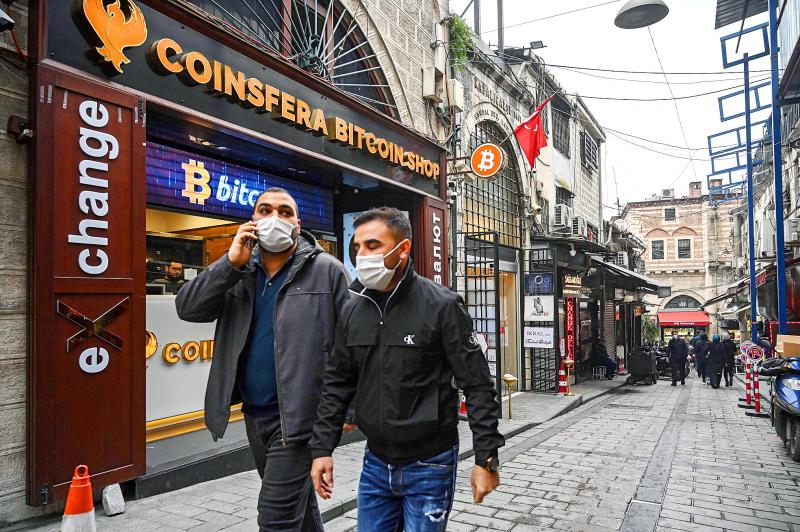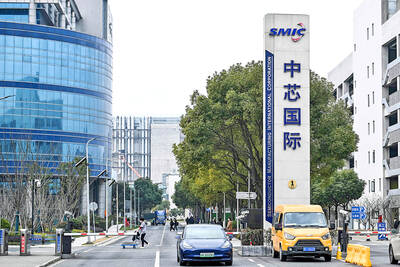Bitcoin’s wild price swings resumed after the world’s largest cryptocurrency for the first time climbed above US$40,000.
After jumping as much as 11 percent to US$40,394, bitcoin fell about US$3,500 in about half an hour and continues to fluctuate. Prices vacillated as much as 17 percent on Monday, after the digital token has more than doubled in less than a month.
Strategists have cited demand from speculative retail traders, trend-following quantitative funds, the rich and even institutional investors as among the reasons for the surge. The total market value of cryptocurrencies on Thursday climbed beyond US$1 trillion for the first time.

Photo: AFP
“Bitcoin continues to defy all expectations and doubters,” said Antoni Trenchev, cofounder and managing partner of Nexo, a cryptocurrency lender. “It’s leaving all other assets trailing in its wake, like it’s done year in, year out for the past decade.”
Bitcoin accounts for about two-thirds of cryptocurrency market value, followed by Ether at about 13 percent, CoinGecko data showed.
Coinbase Inc, the largest US digital exchange, said it is for a second day experiencing “connectivity issues” on its Web site and mobile app.
Digital coins are jumping in a world awash with fiscal and monetary stimulus, even as some commentators fear an inevitable bust and others question the basic integrity of cryptocurrency markets.
Proponents of bitcoin argue that it offers a hedge against US dollar weakness and the risk of faster inflation, similar to gold, while critics decry the intellectual soundness of comparing the two assets.
“The more that people perceive that their assets, particularly their liquid assets such as fiat currencies are eroding in value, the more they will look for alternatives,” said Geoffrey Morphy, president of Bitfarms Ltd, a Canadian cryptocurrency mining company.
Active bitcoin accounts are nearing their all-time high levels of late 2017, according to researcher Flipside Crypto — possibly a sign that some holders are planning to sell.
Fewer than 2 percent of accounts hold 95 percent of bitcoin supply, so a few big trades can impact prices. The last big bitcoin boom began imploding in late 2017.
Some traders pointed to JPMorgan Chase & Co’s long-term bitcoin price forecast of US$146,000 as possibly fueling the rally. Others said that sentiment was boosted by a US regulatory update that allows a class of less volatile coins to be used by banks for payments.
“This parabolic move upwards, with normally staid Wall Street firms including JP Morgan calling US$146,000 as their price target for Bitcoin, and Guggenheim called US$400,000, feels like it has a long way to go before exhausting,” eToro US managing director Guy Hirsch said. “It wouldn’t be all that surprising to see US$100,000 at some point this year, given the current momentum.”

SEMICONDUCTOR SERVICES: A company executive said that Taiwanese firms must think about how to participate in global supply chains and lift their competitiveness Taiwan Semiconductor Manufacturing Co (TSMC, 台積電) yesterday said it expects to launch its first multifunctional service center in Pingtung County in the middle of 2027, in a bid to foster a resilient high-tech facility construction ecosystem. TSMC broached the idea of creating a center two or three years ago when it started building new manufacturing capacity in the US and Japan, the company said. The center, dubbed an “ecosystem park,” would assist local manufacturing facility construction partners to upgrade their capabilities and secure more deals from other global chipmakers such as Intel Corp, Micron Technology Inc and Infineon Technologies AG, TSMC said. It

NO BREAKTHROUGH? More substantial ‘deliverables,’ such as tariff reductions, would likely be saved for a meeting between Trump and Xi later this year, a trade expert said China launched two probes targeting the US semiconductor sector on Saturday ahead of talks between the two nations in Spain this week on trade, national security and the ownership of social media platform TikTok. China’s Ministry of Commerce announced an anti-dumping investigation into certain analog integrated circuits (ICs) imported from the US. The investigation is to target some commodity interface ICs and gate driver ICs, which are commonly made by US companies such as Texas Instruments Inc and ON Semiconductor Corp. The ministry also announced an anti-discrimination probe into US measures against China’s chip sector. US measures such as export curbs and tariffs

The US on Friday penalized two Chinese firms that acquired US chipmaking equipment for China’s top chipmaker, Semiconductor Manufacturing International Corp (SMIC, 中芯國際), including them among 32 entities that were added to the US Department of Commerce’s restricted trade list, a US government posting showed. Twenty-three of the 32 are in China. GMC Semiconductor Technology (Wuxi) Co (吉姆西半導體科技) and Jicun Semiconductor Technology (Shanghai) Co (吉存半導體科技) were placed on the list, formally known as the Entity List, for acquiring equipment for SMIC Northern Integrated Circuit Manufacturing (Beijing) Corp (中芯北方積體電路) and Semiconductor Manufacturing International (Beijing) Corp (中芯北京), the US Federal Register posting said. The

India’s ban of online money-based games could drive addicts to unregulated apps and offshore platforms that pose new financial and social risks, fantasy-sports gaming experts say. Indian Prime Minister Narendra Modi’s government banned real-money online games late last month, citing financial losses and addiction, leading to a shutdown of many apps offering paid fantasy cricket, rummy and poker games. “Many will move to offshore platforms, because of the addictive nature — they will find alternate means to get that dopamine hit,” said Viren Hemrajani, a Mumbai-based fantasy cricket analyst. “It [also] leads to fraud and scams, because everything is now